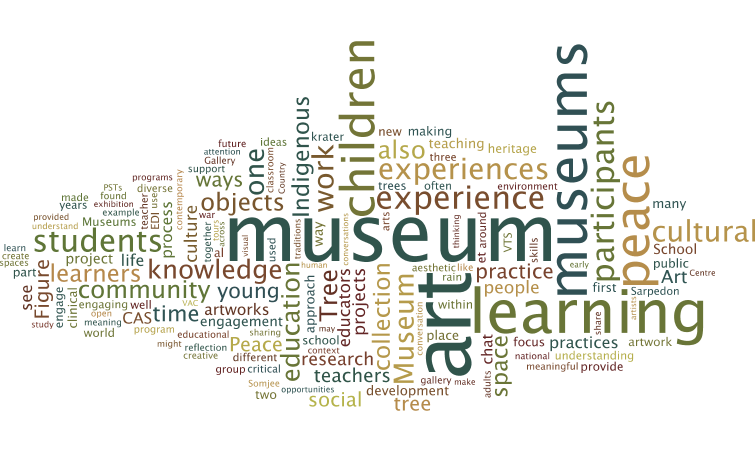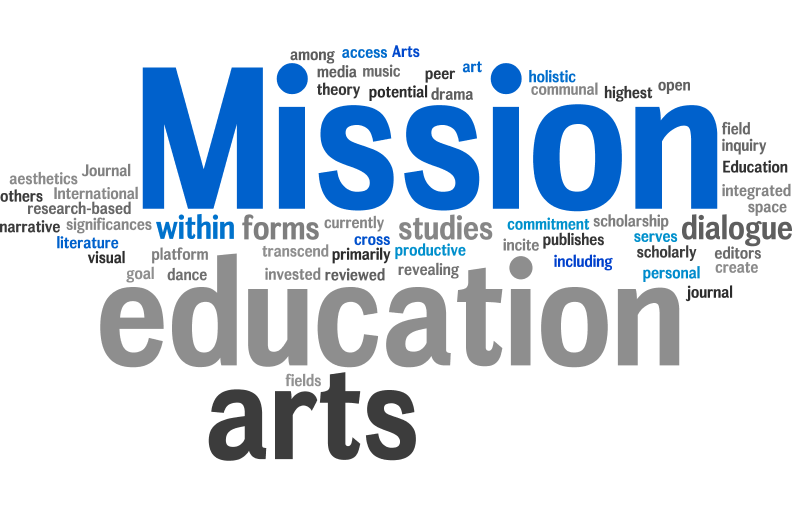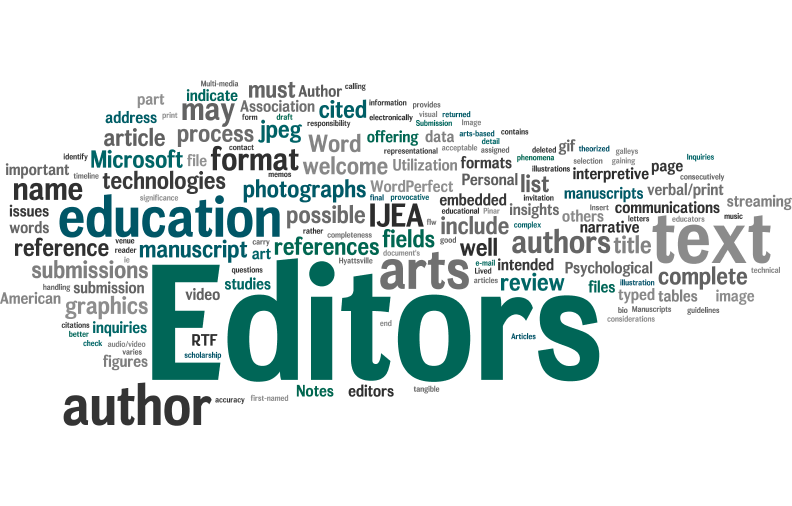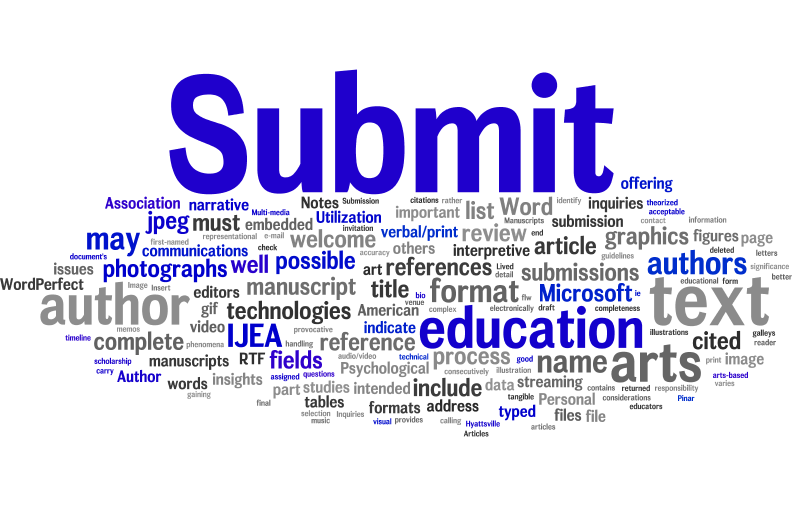| Volume 24 Special Issue 1 | June 13, 2023 |
Museum Education: Multiple Perspectives
Boyd White, Guest Editor
McGill University, Canada

Articles
Editorial
Museum Education: Multiple Perspectives
Boyd White, Guest Editor
We might call this issue a pandemic offspring. Initially, colleagues and I received federal funding to conduct a study of teacher education student learning prompted by interactions with artworks at the Montreal Museum of Fine Arts. We had barely got started when the pandemic forced the closure of the museum and drastically altered our teaching and research strategies. Our study depended upon interactions with actual artworks (not digital reproductions), extensive in-person group work, and flexible scheduling, so it became immediately apparent that our original plans were not going to work. Rather than trying to redesign our study into something we felt would be a pale version of the original plan, we decided, instead, to invite museum educators to write about their current work; and we would publish the papers, in one format or another. This issue is one result of that call for papers. It provides an overview of educators currently working within the contexts of their particular and varied connections to museum education, and from many parts of the world.
This issue contains eleven articles divided into five sections. Links will be apparent, not only within sections but from one to another. Where the goals of the author(s) signal a somewhat different direction, I have inserted a new section. The first section, articles 1 & 2, address primary education specifically. The second section, articles 3 & 4, take a more global view of museum education, although article 3 does also prioritize primary education. Section 3, articles 5 – 7, look at museums where art is not the primary focus. Section 4, articles 8 & 9, return to a focus on art museums, but for purposes unlike those addressed in the earlier articles. The final section, articles 10 & 11, look at equity and related issues from quite different standpoints. At the risk of over-simplifying, here, I will provide a brief overview of the articles.
Read More | Full Text PDFSection 1
Volume 24 Special Issue 1.1
Learning-to-Learn-With a Boon Wurrung Tree
by Geraldine Burke, Melissa Bedford, Moorina Bonini, Carolyn Briggs, Charlotte Day, Ginette Pestana
This article explores the layered impact of partnership learning across museum, pre-service education and school contexts where the agency of trees provokes new insights for art education practices. It features collective experiences of a Tree School and Tree Story exhibition along with associated Art-Reach experiences between pre-service teachers (PSTs) and early primary school children. For us, the culturally-marked Boon Wurrung tree was a central inspiration for cross-institutional learning. It energised our understanding of Indigenous knowledges and provoked ways to re-imagine how we explore Indigenous perspectives through art education as entangled with Museum education.
Read More | Full Text PDFVolume 24 Special Issue 1.2
Conversations With Rain: Proposing Poetic and Non-linear Interpretation Strategies in the Art Gallery
by Lilly Blue, Jo Pollitt & Mindy Blaise
Conversations with Rain aims to disrupt conventional socio-constructivist and cognitive notions of the child familiar in museum settings by rethinking children’s relations with art objects and weather worlds. Our rationale suggests that poetic and non-linear interpretation strategies, combined with artist studio practices that heighten presence and attention, expand the potential of more porous entanglements for children with the world, and potentially transform our climate futures. Disrupting didactic Gallery programming and environmental ‘learning about’ practices, we propose responsive, participatory, multisensory, open-ended, and poetic opportunities that recognise the unfixed, iterative, and tacit knowledges of the child. Building a body of research through a suite of five creative outputs Conversations with Rain contributes to more-than-human pedagogies that investigate how interdisciplinary, embodied, and practice-led approaches deepen engagement, lead to more responsive nature and culture relations, and enliven connection and empathy with children, art objects, and the world.
Read More | Full Text PDFSection 2
Volume 24 Special Issue 1.3
‘Museum Mindfulness’ as Space, Place, and Provocation: Supporting Global Development, Community, and Identity in Early Childhood
by Sheryl Smith-Gilman
While this article focuses on activities and classroom practices that provide for children’s learning, its main objective aims to underscore how considering museums as space and place and creating a sense of ‘museum mindfulness,’ can activate young children’s global development. Furthermore, the provocation of museum characteristics as an environmental proponent, a space of “the third teacher”, as proposed by the Reggio Emilia approach, may indeed support a communal place for early development of holistic human growth. Such experiences at integral stages of development can lay foundations of identity, powerful enough to rouse one’s sense of self and place in the world.
Read More | Full Text PDFVolume 24 Special Issue 1.4
Socially Engaged Pedagogy in the Zoom Age
by Janet Lee, Michelle Antonisse & Alice Bebbington
Over the course of the COVID-19 pandemic, the Museum of Contemporary Art’s Education Department was, as were many others, confronted with our audience’s rapidly changing needs in a newly digital landscape. As LAUSD closed down all in- person instruction on March 16, 2020, teachers, educators, and families were faced with new challenges in providing adequate access to online distance learning for every student. And yet, Educators in MOCA’s School Program, Contemporary Art Start, were determined we could adapt. It was through a sustained commitment to DEAI work, months of action research, ongoing critical reflection, and our unique team culture created by a robust community of practice that MOCA Educators found ways to not only respond to the challenges posed by virtual learning, but even found space to joyously innovate and enact our values in new and exciting ways. Contemporary Art Start (CAS), MOCA’s award-winning year-long school partnership program, serves five thousand students and one hundred teachers annually from elementary, middle, and high schools across L.A. Facilitating six tours weekly, CAS Educators use the inquiry-based teaching methodology, Visual Thinking Strategies (VTS), to lead learner- centered conversations about contemporary artworks. The teachers in CAS are trained to use VTS in the classroom. In tandem with their two visits to MOCA each year, teachers attend PD workshops, are given a contemporary art curriculum, and receive classroom coaching visits from CAS Educators. Starting in January 2021 under a grant provided by the Leonard Hill Charitable Trust, the CAS program will expand, growing its staff and serving a burgeoning network of teachers and students throughout Los Angeles. In the Summer of 2020, CAS transitioned to online programming. Preparing to lead virtual tours and programs on Zoom in the Fall of 2020, the team of CAS Educators reflected on the pedagogy of VTS and our departmental values of embracing the multiplicity of perspectives, increasing access to contemporary art, and making education more collaborative, inclusive, and learner-centered. We pondered: what would it look like to adapt socially-engaged pedagogy to the Zoom age and could our impact be tangibly measured? In order to center student voices and acknowledge the multiplicity of perspectives, we focused on the new ways students were communicating over Zoom. Striving to facilitate rich VTS discussions with new modes of digital communication, we wondered: As socially-conscious facilitators, what should we privilege when navigating virtual environments? How could the use of online functions, such as chat, align with the goals and values of VTS and CAS? Furthermore, in the endeavor to make education more inclusive and learner-centered, we critically examined our own process of image selection and the possible social implications of artworks. Looking to increase public accessibility to contemporary art, we experimented with digital tools to help reach new audiences. Through these adaptations, we emerged with novel ways to facilitate rich VTS conversations online. Our process of adapting the program continues to this day, as Contemporary Art Start continues to privilege the iterative nature of social praxis and values transformation through reflection.
Read More | Full Text PDFSection 3
Volume 24 Special Issue 1.5
Museum, a Space for [A]culturing Authentic Aesthetic Sensibilities
by Attwell Mamvuto & Biggie Samwanda
This exploratory paper examines the critical role of a museum in Zimbabwe, for the provision of educational programs for learning about aesthetics, which, we argue, is critical for understanding art objects and their contexts. It provides insights into how the museum space extends the school art curriculum. As an institution laden with cultural objects that can lead to increased understanding of cultures and societies, we propose strategies for engaging learners in critical, reflective and experiential learning guided by the scholarship of museum educators in collaboration with teachers. Issues covered in the paper include: observing how museum visitors, including students, reconstruct meaning; programming collaborative activities in a museum; fostering aesthetic and social encounters with visual objects; and promoting stakeholder partnerships between museums and schools. The overall objective of the paper is to describe how, in Zimbabwe, we foster experiential learning for the museum visitor.
Read More | Full Text PDFVolume 24 Special Issue 1.6
Visualizing Peace Museums: A Historical Reflection and Culture-based Exploration
by Kimberly Baker
This article explores peace museums, a unique and under-reported genre of museums, discusses the history of peace museums in Europe, identifies common themes of peace museums globally, and focuses on the emergence of culture-based peace museums in Eastern Africa. The aim is to understand how Kenyan ethnographer Sultan Somjee founded 23 Africanized peace museums and the Community Peace Museums Heritage Foundation (CPMHF) based on the African humanist philosophy of Utu. Even though Somjee and the CPMHF curators offer a relevant approach to peace museum work, they have not received adequate attention or study in their own right. By distilling their 26 years of research and experience, this investigation examines and critically reflects upon the ways Somjee and the CPMHF act as peace activists, and agents of change by promoting Utu values to create lasting social cohesion, resolving conflicts, and fostering reconciliation. This article offers museum educators an alternative approach to peace museum best practices by illustrating how they draw on the peace heritage traditions and knowledge of Indigenous cultures to act as peacemakers in a modern world.
Read More | Full Text PDFVolume 24 Special Issue 1.7
4213 Cigarette Stubs: An Ineffable Display of People and Things
by Ismail Ozgur Soganci
This essay includes descriptions of three instances of artistic production: A song, a tapestry project, and a novel-museum duo. All three convey a mutual inclination toward individuals and objects in differing ways. The third instance, a non-traditional permanent installation in the Museum of Innocence in Istanbul, is called 4213 Cigarette Stubs. In the final sections of the essay, singling out this installation, I try crystallizing the educational aura even mundane objects can create when they are presented within the playful context of artistic expression. The focus in the discussion is on such aura in which sensing, remembering, thinking, comparing, empathizing, interpreting, and learning cohabit.
Read More | Full Text PDFSection 4
Volume 24 Special Issue 1.8
Cultivating an Embodied Interpretative Consciousness: Health Humanities Initiatives at the Montreal Museum of Fine Arts
by Jiameng Xu, Marilyn Lajeunesse & Melissa Park
Partnerships between museums and medical faculties have increased, with the majority focused on building aptitudes related to clinical reasoning or therapeutic use of self. We report on the results of a partnership between the Montreal Museum of Fine Arts and the Faculty of Medicine and Health Sciences at McGill University. The Physician Apprenticeship elective focused on aptitudes, such as deep seeing while the Narrative Rehabilitation initiative focused on bodily sensing and hermeneutic competencies, including reflexivity on how past experiences enter interpretive processes. Tracing the impact in a participant learner’s detailed description of a clinical encounter suggests how these two programs result in, what we are calling, embodied interpretive consciousness. The chapter includes descriptions of, and suggests how, the museum educator’s techniques running both programs may be essential for cultivating intersubjective and embodied professional reasoning competencies needed to understand what might matter most to those with whom health professionals work.
Read More | Full Text PDFVolume 24 Special Issue 1.9
Meaningful Engagement With an Art Museum Collection
by Charmaine Zammit
This article concerns the scenarios of museum education outreach that engages young people with an art museum collection. It includes examples of strategies that have been applied throughout action-research projects involving the learning experience of three different communities of young adults. The projects engaged the participants in holistic educational experiences as they explored their own narratives while engaging with art. The participants’ constant feedback gradually shaped up the educational strategies of the projects, targeting their own specific interests, narratives and needs. Although the projects did not aim at providing art therapy, being “liberating processes in themselves” (Gutierrez, 2016, p. 61) as the participants’ knowledge agenda, interests and needs were prioritized, they could still have led to transformations. In view of the mentioned projects, the article points out a series of recommendations that could help to direct art museum holistic educational outreach programs.
Read More | Full Text PDFSection 5
Volume 24 Special Issue 1.10
The Gallery Art Hive as a Metaphor for Equity, Diversity, and Inclusion Initiatives
by Natasha Reid
This article explores how a visual metaphor offered inspiration for and was influenced by equity, diversity, and inclusion (EDI) efforts being implemented in an established art education center. The art hive within this center’s contemporary art gallery is examined as a metaphor for the organization’s EDI work. Each month, the art hive transformed the gallery into an inclusive environment for diverse participants, established a sharing culture, and emphasized process and action. These characteristics aligned with the methods the organization was employing to create institutional shifts in relation to EDI. The author, who was the Director of this art education center, began to use the art hive as a metaphor for the organization’s vision for EDI work to help community members see possible futures, understand the work ahead, and further spark motivation for this journey. The correlations between the gallery’s art hive and the organization’s EDI efforts are examined.
Read More | Full Text PDFVolume 24 Special Issue 1.11
The Euphronios Krater: Education, Stewardship, and Public Trust
by Rika Burnham
Acquired in 1972, the Euphronios krater reigned as a masterpiece at the Metropolitan Museum of Art for nearly four decades. Its restitution to Italy in 2008 constituted a loss felt acutely by curators, the public, and the museum’s educators. This essay explores dialogic interpretations of the krater’s iconography developed in gallery programs led by the author as a route into questions of stewardship raised by restitution, examining how objects are restored to life by shared acts of attentive looking. The essay further considers convergent issues of deaccessioning and calls for the inclusion of museum educators’ voices as advocates for the public trust in all decision making that affects museums’ collections.
Read More | Full Text PDF



